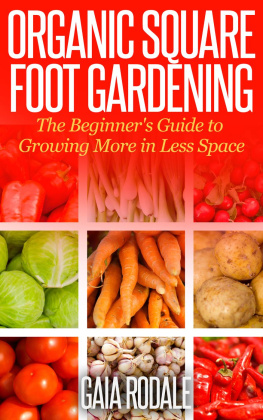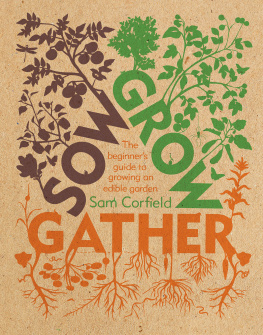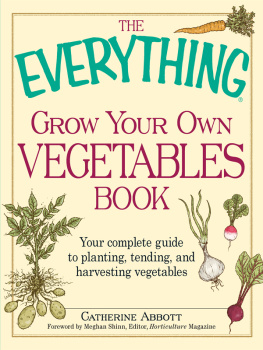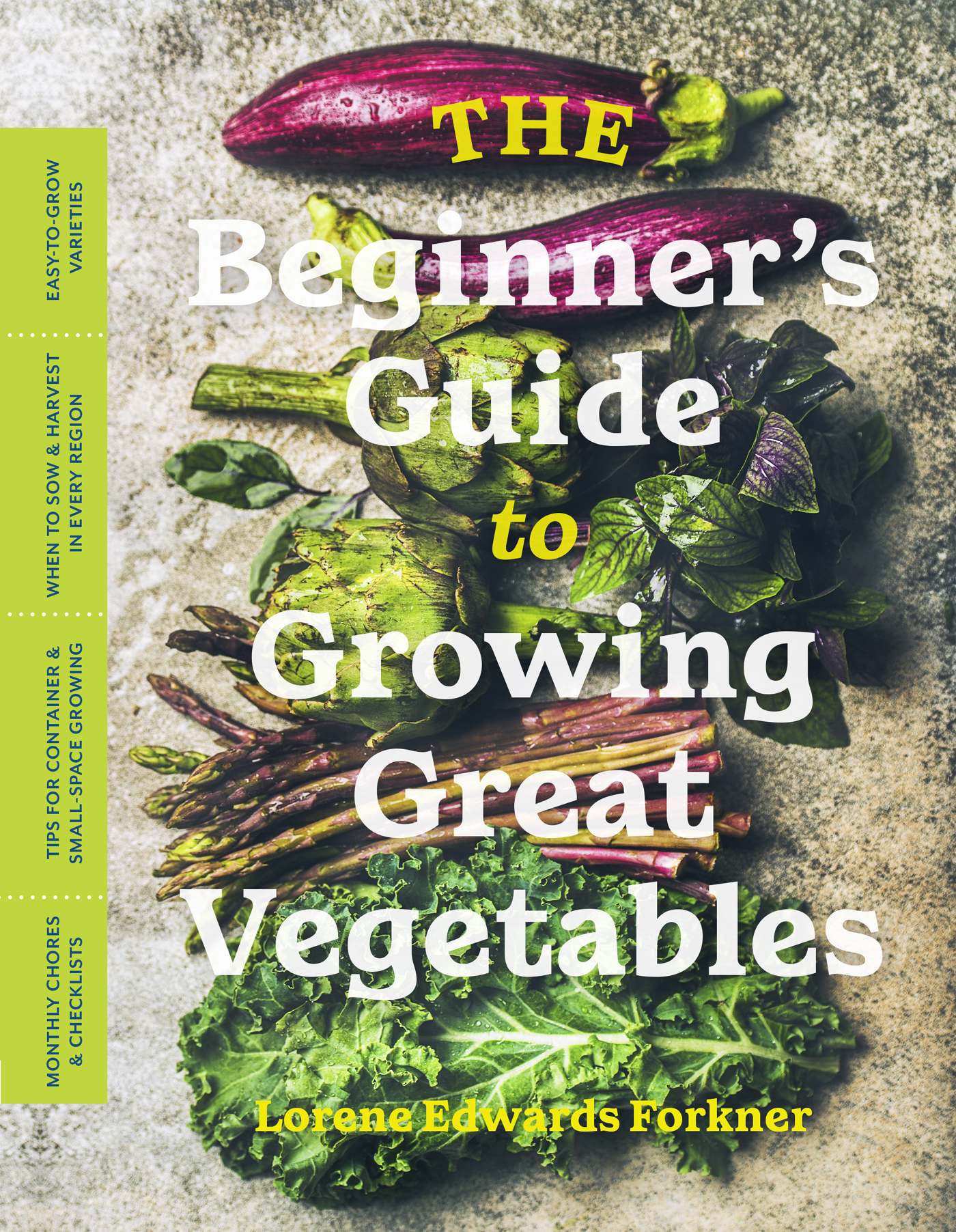THE BEGINNERS GUIDE TO
Growing Great Vegetables
Lorene Edwards Forkner
TIMBER PRESS
Portland, Oregon

For Vito and Brody and all growing gardeners
CONTENTS

PREFACE
Growing fruits and vegetables is a crazy good thing. I love it. From the first chilly day when I bundle up and venture outside to briskly poke pea seeds into the wet soil to hot summer afternoons spent staking tomatoes, their sticky foliage enveloping me in a slightly bitter herbal aroma and staining my fingers oliveI find the entire process endlessly appealing. But all that pales next to the sheer pleasure of harvesting crops in their prime from the backyard, patio, or windowsill. Its all about the food, people!
If youre new to gardening, prepare to be delighted. In addition to producing delectable crops, tending a garden cultivates independence and good health. Gardening is a family-friendly outdoor activity, and it may even save you money on groceries. But thats not all. As a gardener, youll find yourself a part of the living web of nature, filled with amazing plants and beneficial insects and soil critters. Get a growing season or two under your belt and soon youll be plotting and planting throughout the year, filling your days (and possibly nights) with dreams of homegrown goodness.
No matter what youre looking to harvest a windowsill crop of midwinter microgreens, fresh salads spring through fall, a bumper crop of tomatoes, or a few savory herbs to enliven your dinnerthis is your guide to navigating the delicious possibilities available to the home grower. The book takes you through every month of the year, while building your gardening know-how. Youll find tips and techniques as well as suggestions for what to grow and how. You can read this book cover to cover on a cold winter night for a complete crash course in edible gardening. Or you can pick it up midsummer and discover how to turn the seedlings you purchased on a whim at the farmers market into a tasty, healthy harvest.
Whether youre new to growing or a seasoned green thumb, cultivating a garden is a continuing education as well as a nearly constant feast. Some years are more challenging or fruitful than others, and sometimes the harshest seasons turn out to be the best teachers. Just remember to keep track of the highs and the lows, the wins and the losses in your garden journal, and it will become your most trusted tool.
Welcome to a good and delicious life. Dig in!

ACKNOWLEDGMENTS
Tending a garden is a delicious invitation to take our rightful place in nature. Gardening matters, my friends. How we conduct our lives, the decisions we make, and the resources we consume are a lasting legacy. Making a garden is generous. It is an act of love and a force for good. And we get tomatoes!
Thank you to the team at Timber Press, who understand and support the power of gardens to nurture the environment as they feed us in body and spirit. Im grateful for this opportunity to invite beginning gardeners into a life of growing. And gratitude and love to my husband for tending the hose while I wrote this book.

Get Started



With a little know-how, the skys the limit when it comes to growing your own great vegetables.
WELCOME TO GARDENING IN
North America
North America is big, and I mean really big. But as a beginning gardener, all you really need to learn to be a successthink ripe tomatoes, fresh salads, and hearty greensis how to read and work with the growing conditions in your own backyard. Ill say it again and again, all good gardening is local.
Weather
Gardeners love to talk about the weather. But theres weather, whats happening right now, and then theres climate, a regions general weather conditions over a period of time. Where you live determines what you can grow and when.
In 1960, the U.S. Department of Agriculture ( USDA ) devised a map dividing the country into ten hardiness zones. Because they are based solely on minimum winter temperatures, however, USDA hardiness zones have drawbacks in those parts of the country, like the Southeast and Southwest, where soaring summer temperatures limit the growing season. Nevertheless, this map became the industry standard for most garden books and plant labels. The updated 2012 USDA Plant Hardiness Zone Map has improved computing models that take into account elevation, slope, and the moderating influence of neighboring bodies of water. This highly detailed, interactive online map allows you to more accurately pinpoint where your garden falls within the system simply by entering your zip code ( planthardiness.ars.usda.gov ).
As a beginning gardener, the best thing you can do is to develop an understanding of the climate and a feel for the weather of your growing region. This takes time, experience, observation, and, yes, more than a few disappointing losses as you try to predict, gamble, complain, and cajole circumstances to get every last drop of goodness out of the growing season. But once you learn to work with conditions in your garden, youre on your way to a bountiful harvest.
Fresh food awaits, and I know you cant wait to dig in. But first, lets look at the five primary growing regions spread across the United States and southern Canada. Although each region is filled with countless topographic variations and microclimates that influence local growing conditions, broadly speaking each has commonalities that distinguish it from conditions in other growing regions.
GROWING REGIONS


The five growing regions that span the United States and southern Canada each share a unique set of growing conditions.
Growing Regions
 The Pacific Northwest ( PNW ) growing region encompasses coastal northern California, western Oregon, western Washington, southern British Columbia, and southeastern Alaska. The regions proximity to mountain ranges and neighboring bodies of water influences weather patterns and accounts for local variations, producing a long, mostly frost-free growing season. Summerswhile warm, pleasant, and generally dryrarely get hot enough to hinder plants that dont do well in heat. Pacific Northwest gardeners will sometimes struggle to ripen warm-season crops like tomatoes, peppers, and eggplants, but theyll always have kale and other hardy crops that produce in fall and over winter.
The Pacific Northwest ( PNW ) growing region encompasses coastal northern California, western Oregon, western Washington, southern British Columbia, and southeastern Alaska. The regions proximity to mountain ranges and neighboring bodies of water influences weather patterns and accounts for local variations, producing a long, mostly frost-free growing season. Summerswhile warm, pleasant, and generally dryrarely get hot enough to hinder plants that dont do well in heat. Pacific Northwest gardeners will sometimes struggle to ripen warm-season crops like tomatoes, peppers, and eggplants, but theyll always have kale and other hardy crops that produce in fall and over winter.














 The Pacific Northwest ( PNW ) growing region encompasses coastal northern California, western Oregon, western Washington, southern British Columbia, and southeastern Alaska. The regions proximity to mountain ranges and neighboring bodies of water influences weather patterns and accounts for local variations, producing a long, mostly frost-free growing season. Summerswhile warm, pleasant, and generally dryrarely get hot enough to hinder plants that dont do well in heat. Pacific Northwest gardeners will sometimes struggle to ripen warm-season crops like tomatoes, peppers, and eggplants, but theyll always have kale and other hardy crops that produce in fall and over winter.
The Pacific Northwest ( PNW ) growing region encompasses coastal northern California, western Oregon, western Washington, southern British Columbia, and southeastern Alaska. The regions proximity to mountain ranges and neighboring bodies of water influences weather patterns and accounts for local variations, producing a long, mostly frost-free growing season. Summerswhile warm, pleasant, and generally dryrarely get hot enough to hinder plants that dont do well in heat. Pacific Northwest gardeners will sometimes struggle to ripen warm-season crops like tomatoes, peppers, and eggplants, but theyll always have kale and other hardy crops that produce in fall and over winter.